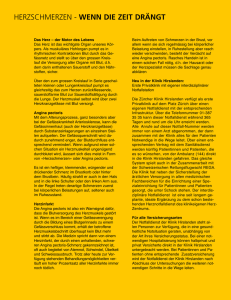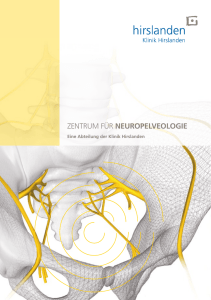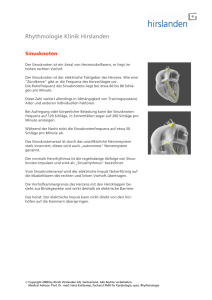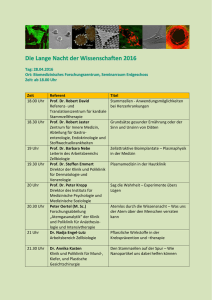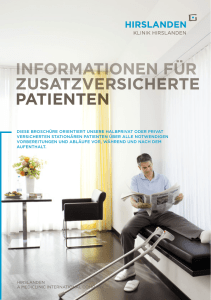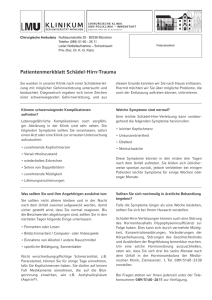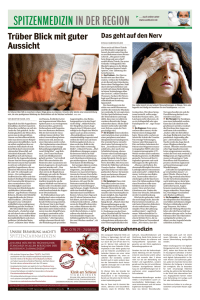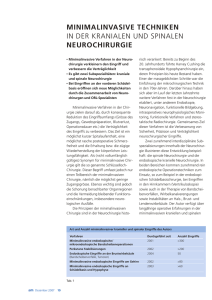Erfolgreiche Entfernung von Krebstumoren im Verdauungstrakt
Werbung
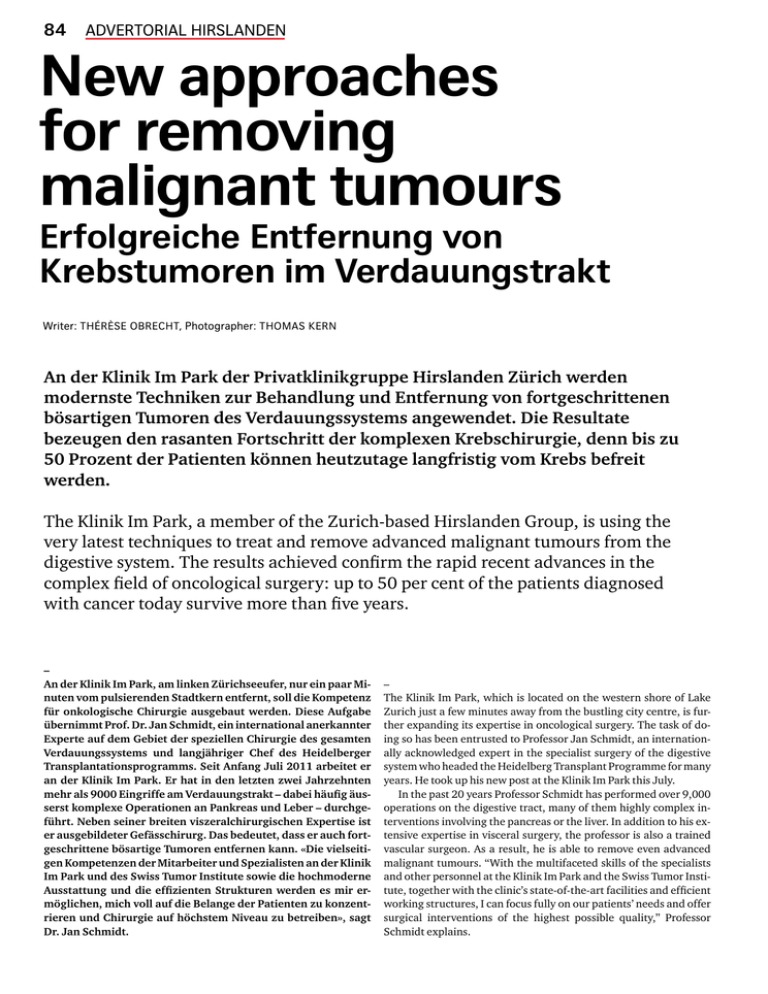
84 advertorial hirslanden New approaches for ­removing malignant ­tumours Erfolgreiche Entfernung von Krebstumoren im Verdauungstrakt Writer: Thérèse Obrecht, Photographer: Thomas Kern An der Klinik Im Park der Privatklinikgruppe Hirslanden Zürich werden ­modernste Techniken zur Behandlung und Entfernung von fortgeschrittenen bösartigen Tumoren des Verdauungssystems angewendet. Die Resultate ­bezeugen den rasanten Fortschritt der komplexen Krebschirurgie, denn bis zu 50 Prozent der Patienten können heutzutage langfristig vom Krebs befreit ­werden. The Klinik Im Park, a member of the Zurich-based Hirslanden Group, is using the very latest techniques to treat and remove advanced malignant tumours from the digestive system. The results achieved confirm the rapid recent advances in the complex field of oncological surgery: up to 50 per cent of the patients diagnosed with cancer today survive more than five years. – An der Klinik Im Park, am linken Zürichseeufer, nur ein paar Minuten vom pulsierenden Stadtkern entfernt, soll die Kompetenz für onkologische Chirurgie ausgebaut werden. Diese Aufgabe übernimmt Prof. Dr. Jan Schmidt, ein international anerkannter Experte auf dem Gebiet der speziellen Chirurgie des gesamten Verdauungssystems und langjähriger Chef des Heidelberger Transplantationsprogramms. Seit Anfang Juli 2011 arbeitet er an der Klinik Im Park. Er hat in den letzten zwei Jahrzehnten mehr als 9000 Eingriffe am Verdauungstrakt – dabei häufig äus­ serst komplexe Operationen an Pankreas und Leber – durchgeführt. Neben seiner breiten viszeralchirurgischen Expertise ist er ausgebildeter Gefässchirurg. Das bedeutet, dass er auch fortgeschrittene bösartige Tumoren entfernen kann. «Die vielseitigen Kompetenzen der Mitarbeiter und Spezialisten an der Klinik Im Park und des Swiss Tumor Institute sowie die hochmoderne Ausstattung und die effizienten Strukturen werden es mir ermöglichen, mich voll auf die Belange der Patienten zu konzentrieren und Chirurgie auf höchstem Niveau zu betreiben», sagt Dr. Jan Schmidt. – The Klinik Im Park, which is located on the western shore of Lake Zur­ich just a few minutes away from the bustling city centre, is further expanding its expertise in oncological surgery. The task of doing so has been entrusted to Professor Jan Schmidt, an internationally acknowledged expert in the specialist surgery of the digestive system who headed the Heidelberg Transplant Programme for many years. He took up his new post at the Klinik Im Park this July. In the past 20 years Professor Schmidt has performed over 9,000 operations on the digestive tract, many of them highly complex interventions involving the pancreas or the liver. In addition to his extensive expertise in visceral surgery, the professor is also a trained vascular surgeon. As a result, he is able to remove even advanced malignant tumours. “With the multifaceted skills of the specialists and other personnel at the Klinik Im Park and the Swiss Tumor Institute, together with the clinic’s state-of-the-art facilities and efficient working structures, I can focus fully on our patients’ needs and offer surgical interventions of the highest possible quality,” Professor Schmidt explains. advertorial hirslanden 85 Prof. Dr. Jan Schmidt, ein an­ erkannter Exper­ te der speziellen Tumorchirurgie, führt seit zwei Jahrzehnten komplexe Ein­ griffe am Ver­ dauungstrakt durch. Seit Juli verstärkt er das Team der Hirs­ landen Klinik Im Park. Professor Jan Schmidt, an acknowledged expert in specialist tumour surgery, has been performing complex operations on the digestive tract for some 20 years now. He joined the Hirslanden Klinik Im Park team in July. Die Leber ist ein äusserst komple­ xes Organ, das sich in acht Seg­ mente aufteilen lässt. Jedes die­ ser Segmente ist eine funktionie­ rende Unterein­ heit. Schon zwei gesunde Seg­ mente nach einer Leberteilentfer­ nung reichen aus, um ein nor­ males Leben füh­ ren zu können. The liver is a highly complex organ that can be divided into eight segments, each of which is a functioning sub-unit of its own. As few as two such segments are needed after removal of part of the liver for the patient to continue to lead a normal life. 86 advertorial hirslanden © Springer Medizin Verlag 2007, Chirurg 2007; 78: 761–774 Die einzigartige Regenerationsfähigkeit der Le­ ber hilft mit, bösartige Tumoren in zwei oder mehreren Operationen «auszutricksen» (a–c). Hier wird zunächst mit einer kleinen Operation die linke Leberhälfte tumorfrei gemacht (b). Nach einer künstlichen Verstopfung eines ­rechten Blutge­fäs­ses wächst die linke Leber­ hälfte rasch heran. Nun kann die rechte Leber­ hälfte risikoarm entfernt werden (c). a) b) c) Die Behandlungsmöglichkeiten für die meisten bösartigen Krebserkrankungen, zum Beispiel von Leber- und Bauchspeicheldrüsentumoren, haben sich in den letzten Jahren rasant entwickelt. Die laufend verbesserte Bildgebung (Computertomografie, Magnetresonanztomografie, Ultraschall, PET) erlaubt eine präzisere Diagnose. Doch erfolgt diese – aufgrund der diffusen, unspezifischen Symptome – meist erst dann, wenn die Krankheit weit fortgeschritten ist. Lebermetastasen sind auch heute noch eine der häufigsten Todesursachen vor allem von Tumoren des Verdauungssystems, zum Beispiel im Dickdarm. Die chirurgische Entfernung, meist in Verbindung mit Chemotherapie und lokal-ablativen Verfahren, kann in zahlreichen Fällen zur Heilung führen. Vielfach ist die Verteilung der Metastasen jedoch derart, dass eine vollständige Entfernung aller Herde schwierig ist. Durch eine ausgeklügelte Vor- und Nachbehandlung gelingt es jedoch oft, die Leber von allen Herden manchmal in zwei oder mehr Operationen zu befreien. Dazu trägt die einzigartige Fähigkeit der Leber zu regenerieren bei. Nehmen wir an, ein Patient leide an Lebermetastasen, die in allen acht Segmenten der Leber verteilt sind (Bild a). Drei Metastasen liegen relativ peripher an der linken Leberoberfläche und können in einer ersten, kleinen Operation entfernt werden (Bild b). Anschliessend erfolgt in der interventionellen Radiologie eine Verstopfungsbehandlung (Pfortaderembolisation) der rechten, hauptsächlich tumorbefallenen Seite. Da diese Leberseite noch ein weiteres Blutgefäss hat, das sie versorgt, bleibt sie zwar am Leben, wird aber kleiner. Die andere, nun tumorbefreite Seite wächst innerhalb von ein paar Wochen rasch heran. Nun kann in einer zweiten Operation die rechte, noch tumortragende Seite sicher entfernt werden, da auf der anderen Seite genügend gesundes Lebergewebe zur Verfügung steht (Bild c). Der Patient ist somit tumorfrei. Zu den weiteren Möglichkeiten, den Krebs «auszutricksen», gehören auch die Vorbehandlung der Leber mittels neoadjuvanter Chemotherapie zur Verkleinerung der Metastasen oder die Verbrennung kleiner Herde mittels Radiofrequenzablation. Ganz komplizierte Fälle können mit der sogenannten kalten Chirurgie behandelt werden. Hierbei wird die ganze Leber von der Blutzirkulation abgeschnitten und mit kalter Organkonservierungslösung durchströmt. Durch diese Kühlung können nun auch Tumore entfernt werden, die die Gefässe in der Leber selbst angegriffen haben, da genügend Zeit zur Verfügung steht, diese zu rekonstruieren. In Verbindung mit einer adjuvanten Nachbehandlung können so bis zu 50 Prozent der Patienten lang­­fristig vom Krebs befreit werden. The liver’s unique regenerative capacity can help the medical world to “outsmart” malignant tumours in a multiple-intervention approach (a–c). A first, small operation removes any tumours from the left side of the organ (b). Next, the blood vessel feeding the right side is artificially blocked, prompting the left side to grow rapidly in compensatory response. This then allows the right side to be removed with minimal risk to the patient (c). The possibilities for treating most malignant cancers, such as tumours which develop in the liver or the pancreas, have increased dramatically in the past few years. The steady improvements in imaging (through computer tomography, magnetic resonance tomography, ultrasound and PET) now permit more accurate diagnosis. As a result of the vague and varied symptoms that patients tend to suffer, however, such imaging is often only performed when the cancer is already well advanced. Liver metastasis is still one of the commonest causes of death today, especially when the case involves tumours of the digestive system, such as in the colon. Often, surgical removal – usually performed in combination with chemotherapy and/or local ablative procedures – can lead to recovery. In numerous cases, however, the metastases have spread to such an extent that it is difficult to fully remove every site thereof. But with sophisticated preparation and follow-up treatment, it is now frequently possible to free the liver entirely from all sources of the metastases, even though it may take multiple operations to do so. The liver’s unique ability to regenerate itself plays a vital role here. Let us assume that a patient is suffering from metastases of the liver which are spread over all eight segments of the organ (image a). Three of the sites are relatively peripheral, on the surface of the liver on the left side, and can be removed in a first, minor operation (image b). This is followed by interventional radiology in the form of a portal vein embolisation which is performed on the right side of the liver, where most of the tumours are located. The right side of the liver will still be kept “alive” through a further blood vessel that serves it; but once its portal vein has been blocked, it will diminish in size. To compensate for this, the left side (which is now free of tumours) will grow quickly in size within just a few weeks. Once it has done so, a further operation can be performed to remove the tumour-infected right side: the patient will now have sufficient healthy liver matter on the left side for this to be safely done (image c). When this operation is complete, the liver will be tumour-free. Further possibilities for “outsmarting” cancer include pre-treating the liver with neoadjuvant chemotherapy to reduce the size of the tumours, or destroying smaller tumours by radiofrequency ablation. Highly complex cases can be treated using “cold surgery”: the entire liver is cut off from the usual blood flow and is then flooded with a cold organ preservation solution. The resulting cooling allows even tumours to be removed which have attacked the liver’s vessels themselves, since adequate time will be available to reconstruct these afterwards. If surgery is used in combination with adjuvant follow-up treatment, up to 50 per cent of patients can be freed from cancer long-term. advertorial hirslanden 87 An der Klinik Im Park wird in Zusammen­ arbeit mit dem Swiss Tumor Institute die Kompetenz für onko­ logische Chirurgie weiter ausgebaut. Zurich’s Klinik Im Park is further expanding its expertise in oncologic­ al surgery, in collabor­ ation with the Swiss Tumor Institute. Fortschritte gibt es auch bei der Behandlung von Bauchspeicheldrüsentumoren. Ein Patient leidet zum Beispiel an Bauchspeicheldrüsenkrebs, der in ein grosses benachbartes Gefäss (Pfortader) eingewachsen ist. Bereits zu diesem Zeitpunkt, spätestens aber bei der möglichen Beteiligung von Arterien im Bauchraum, sieht man häufig keine Operationsmöglichkeit mehr. Dank der Anwendung von bestimmten Techniken können jedoch oft auch diese schwierigen Tumoren entfernt werden. Zunächst wird beispielsweise eine Vorbehandlung mit einer sogenannten neoadjuvanten (Radio-)Chemotherapie durchgeführt. Nach einer Tumorverkleinerung oder zumindest einer Sterilisation der gefässnahen Tumoranteile kann dann die Operation erfolgen. Um einen optimalen Therapieerfolg zu gewährleisten, muss zusätzlich eine Nachbehandlung (Chemotherapie) erfolgen. Ähnliche, mit den Onkologen, Strahlentherapeuten und Gastroenterologen vernetzte Behandlungskonzepte gibt es für die meisten gastrointestinalen Tumoren und die Weichteiltumoren (Sarkome). Für Prof. Jan Schmidt ist die Interdisziplinarität die Grundlage des Erfolges bei komplexer Chirurgie: «Chirurgen sind heute keine Einzelkämpfer mehr. Ihre Fähigkeiten können sie in enger Zusammenarbeit mit den anderen bei der Krebsbehandlung aktiven Disziplinen zum Wohl der Patienten einsetzen.» Die Voruntersuchung und Planung eines onkologischen Eingriffs dauert an der Klinik Im Park höchstens ein paar Tage, die Operation selbst zwischen zwei und zehn Stunden, der Spitalaufenthalt je nach Fall ein paar Tage oder Wochen. «Ich schätze vor allem die lückenlosen, kontinuierlichen Kontakte mit jedem Patienten von der Vor- bis zur Nachbehandlung», fügt Prof. Schmidt bei, «und ich kann mich voll auf die hervorragende Betreuung auf der Intensivstation und der Pflegeabteilung an der Klinik Im Park verlassen.» • Klinik Im Park, Zürich Die Zürcher Klinik Im Park gehört seit 1990 zur Privatklinikgruppe Hirslanden, der ersten Privatklinikgruppe der Schweiz. In den zahlreichen Kompetenzzentren und Instituten der Klinik Im Park arbeiten ausgewiesene Fachärzte interdisziplinär zusammen. Die medizinische Infrastruktur der Klinik Im Park geniesst in Fachkreisen einen ausgezeichneten Ruf. Patientinnen und Patienten geniessen eine optimale medizinische Betreuung, eine auf die individuellen Bedürfnisse ausgerichtete Pflege sowie eine Hotellerie auf höchstem Niveau. Mehr Informationen finden Sie unter www.hirslanden.ch. Recent advances also include the treatment of pancreatic tumours. Take a patient suffering from a carcinoma of the pancreas with portal vein infiltration. By this point, or at the latest if the cancer is thought to have spread to the local arteries, the operational option is often ruled out. But with the help of certain techniques, even these difficult tumours can frequently be removed. One approach here is to pretreat the patient with neoadjuvant (radio)chemotherapy. Once the tumour has been reduced in size, or at least the tumour parts close to the blood vessels have been sterilised, the operation can be performed. To maximise the chances of success, the oper­ ation must also be followed by chemotherapy. Similar procedures involving oncologists, radiotherapists and gastroenterologists now also exist for treating most gastrointestinal tumours and soft-tissue tumours (sarcomas). For Professor Schmidt, this interdisciplinary approach is the key to the success of any complex surgery. “Surgeons are no longer the ‘solo stars’ of the past,” he observes. “They can use their skills in close collaboration with their colleagues in the other cancer-treating disciplines, all for the benefit of the patient.” At the Klinik Im Park, the preliminary examination and planning for an oncological intervention will take a few days at the most. The operation itself lasts between two and ten hours; and the hospital stay will range from a few days to a few weeks, depending on the precise case details. “What I especially enjoy is the continuous contact with the patient, from the preparation and any pretreatment required right through to the follow-up phase,” Professor Schmidt adds. “And throughout this process, I know I can put my total trust and confidence in the outstanding care that is offered at the Klinik Im Park, in the intensive-care unit and on the nursing wards.” • Im Park Clinic, Zurich Zurich’s Im Park Clinic has been a member of the Hirslanden Group, the first group of private hospitals in Switzerland, since 1990. The highly qualified physicians at the various centres of competence and institutes of the Im Park Clinic work together in an interdisciplinary network. The medical infrastructure of the Im Park Clinic enjoys an excellent ­reputation in specialist circles. Patients benefit from the best medical care, excellent service tailored to their individual requirements and the highest standard of accommodation and catering. More information can be found at www.hirslanden.ch. Prof. Dr. med. Jan Schmidt Seestrasse 90 8002 Zürich T +41 (0)44 208 20 50 F +41 (0)44 208 20 52 www.klinik-impark.ch www.hirslanden.ch [email protected]
